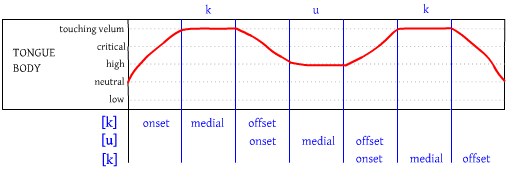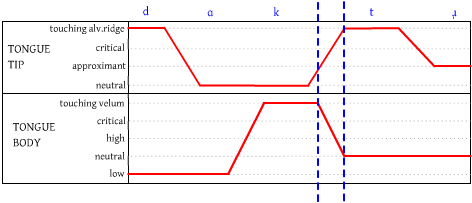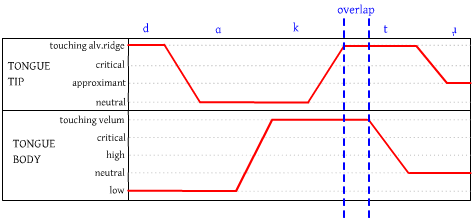| [fəˈnɛɾəks] |

The offset phase of the first [k] overlaps with the onset phase of the [u], and the offset phase of the [u] overlaps with the onset phase of the final [k]. This kind of well-defined transition is physically necessary in this case. It is the tongue body that has to perform both medial phases -- it can't simultaneously be performing the medial phase of the first [k] and already be moving toward the position for the following [u].
In general, though, we don't find clean transitions like this. Whenever more than one articulator is involved, there is the possibility that they're not moving at the same time. In toot , [tut], it is the tongue tip that is performing the medial phase of the initial [t]. There is no physical reason why the tongue body must wait around till the tongue tip releases the [t] before beginning to move into position for the [u] -- and usually it doesn't. The onset phase of the [u] will during the medial phase of the initial [t]. Often the tongue body will even reach its position for the medial phase of [u] before the [t] is released:
Unsynchronized phases during [tut]:

We can see a similar overlap at the end of [tut] as well -- the onset phase of the final [t] begins before the medial phase of the [u] is completed.
Even our ideal [kuk] shows overlapping once we consider the lips as a second articulator. [u] involves both a high back tongue body and lip rounding, but we almost never find the onset and offset of lip rounding occurring synchronized with the onset and offset of the tongue body gesture, which would look like:
Tongue body and lips during [kuk] -- idealized version:
![Tongue body and lips during [kuk]](kuk-phases3.png)
Instead the lip rounding overlaps significantly with the preceding and following consonants:
Tongue body and lips during [kuk] -- more realistic version:

Consonants can overlap each other as well. The word doctor could be pronounced with two different kinds of transitions between the [k] and the [t]. It would be possible for the [k] to be released before the closure of the [t] begins, that is, the offset phase of [k] overlaps with the onset phase of the [t], as in:
[ˈdaktɹ̩] with released [k]:

Or, the [k] might not be released until after the closure of the [t] has already begun, as in:
[ˈdak ̚tɹ̩] with "unreleased" [k]:

Languages differ in which kind of transition they use. Many languages prefer to have a clearly released [k] before the [t], as in the first diagram. English strongly prefers to have an overlapping [kt] sequence, as in the second diagram.
In an IPA transcription, we can indicate an overlapping transition between stops using the same corner diacritic we used for unreleased stops:
[ˈdɑk ̚tɹ̩]
Technically, the IPA corner diacritic means "no audible release". A release might not be audible because it occurs during the closure of a following stop, as in doctor . Or there might be no audible release because there is no release at all, as in phrase-final cat .